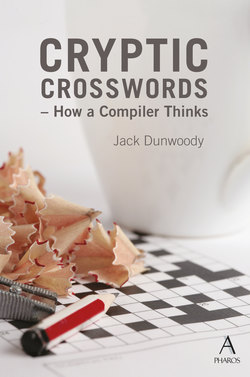Читать книгу Cryptic Crosswords - Jack Dunwoody - Страница 5
На сайте Литреса книга снята с продажи.
ОглавлениеIntroduction
INTRODUCTION
I have to admit upfront that my task as a compiler and yours as a solver are diametrically opposed. I’m there to thwart you but having said that my clues should still get you to the answers. It’s a competition you should win and I should lose gracefully!
When you first look at a cryptic crossword puzzle the overwhelming reaction is to move on to a concise crossword or a Sudoku, and even when you see the answers the next day in the newspaper or at the back of the book, you’re often no wiser as to how the clues relate to the answers.
There are however aspects to the clues that should help you.
Firstly, the compiler gives you the make-up of the answer in the number or numbers appended to the clue. This indicates the number of letters in each word of the solution, for example: (9) means the answer is a single word of nine letters, while (4-5) means the answer is a hyphenated word of nine letters, and (2,4,3) means the answer is a phrase of nine letters. The apostrophe ‘ is not counted or shown in the number at the end of a clue, i.e. Murphy’s law in an answer will show as (7,3) letters.
Secondly, a clue contains a word or a number of words that means the same as the answer. This word or number of words will invariably be at the front of the clue or at the end of the clue. It is the rest of the clue, i.e. the middle words, that defines the answer. This definition needs to be read logically and not literally. The compiler is “building” an answer using other words and you have to think of them merely as component parts, not as a sentence. Grammar falls away and nouns, verbs and adjectives are just words. The clue word may be a noun, but the synonym, or target word, may well be a verb or an adjective!
As a solver you should therefore focus on the beginning and the end of clues and try and decide is the answer going to come from the first word/s of the clue or the last word/s of the clue. The logic of the clue should help you find the clue type that fits the definition . Some solvers find the component parts first while others, generally more experienced, find the answers first and then work out why they fit the component parts.
Cryptic crossword puzzles should contain a spread of types of clues and what you need to get out of THE TECHNIQUES section is to be able to recognise the indicators that point to the different clues. When reading a clue you should ask the questions: Is it an ANAGRAM? Is it a DOUBLE MEANING clue? Is it a SOUNDS LIKE clue?, etc..
If you are a new cryptic solver don’t be too hard on yourself. It will come, but you will certainly not be self-sufficient having just worked through THE TECHNIQUES. I suggest at the end of this book you rather take your first five actual puzzles and just copy across the answers from the newspaper or the back of the book. Then look at each answer and work it back to its clue, like you were doing throughout THE TECHNIQUES. Even if you don’t know a word you should still be able to work out how the clue brings you logically to that answer. You can the check the word in a good dictionary.
Finally what helps the solver is the fact that clues are unambiguous and there can be only one possible answer in the context of the entire puzzle.
